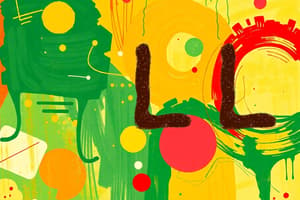Podcast
Questions and Answers
Which approach focuses primarily on different disciplines?
Which approach focuses primarily on different disciplines?
- Multidisciplinary Approach (correct)
- Interdisciplinary Approach
- Transdisciplinary Approach
What is an integrated curriculum?
What is an integrated curriculum?
An integrated curriculum organizes content across various academic disciplines, focusing on basic skills, higher-level thinking, and lifelong learning.
In the interdisciplinary approach, disciplines assume more importance than in the multidisciplinary approach.
In the interdisciplinary approach, disciplines assume more importance than in the multidisciplinary approach.
False (B)
What is project-based learning?
What is project-based learning?
Which method of curriculum integration involves students in experiences that benefit others and the community?
Which method of curriculum integration involves students in experiences that benefit others and the community?
How does the transdisciplinary approach support students?
How does the transdisciplinary approach support students?
What is the main benefit of innovative teachers integrating curriculum?
What is the main benefit of innovative teachers integrating curriculum?
Which of the following is NOT a method of curriculum integration?
Which of the following is NOT a method of curriculum integration?
Study Notes
Concept of Integrated Curriculum
- Introduced in the 1960s, a concept that organizes academic content across various subjects.
- The focus is on developing basic skills, encouraging higher-level thinking, and promoting lifelong learning.
- Structures learning around meaningful concepts, facilitates connections, and encourages active participation in real-life experiences.
Approaches to Integration
- Multidisciplinary Approach: Focuses on teaching individual subjects, creating standards within a theme.
- Interdisciplinary Approach: Organizes and capsulates the curriculum around common learning across subjects, emphasizing interdisciplinary skills and concepts. The subjects are acknowledged, but they are less important than in the multidisciplinary approach.
- Transdisciplinary Approach: Teachers design a curriculum based on student needs and concerns. Students apply disciplinary and interdisciplinary skills in a real-life context.
Methods of Curriculum Integration
- Project-Based Learning: Involves students in varied learning experiences. Often benefits others and the community, while advancing curriculum goals
- Service Learning: Learning that actively involves students in a wide range of experiences, often benefitting others and the community, while also advancing the goals of a given curriculum.
- Center/Parallel Learning: Allows children to role-play to understand and make sense of the real world and their personal experiences.
- Theme-Based: Students exhibit excellent on-task behavior and work collaboratively. Teachers fuse skills, knowledge, or attitudes into the regular school curriculum.
- Fusion: This approach integrates new literacies into various subject areas. Students learn respect for the environment in every subject.
Benefits of Curriculum Integration
- Enhanced student achievement: According to Chhabra (2017), curriculum integration significantly enhances student achievement and standardized scores.
New Literacy Integration in K-12
- The integration of new literacy across disciplines in the K-12 curriculum can lead to improved learning outcomes.
- The incorporation of various new literacies depends on the nature of the lesson and intended outcomes.
Studying That Suits You
Use AI to generate personalized quizzes and flashcards to suit your learning preferences.
Related Documents
Description
Explore the concept of Integrated Curriculum that emerged in the 1960s. This quiz covers various approaches including multidisciplinary, interdisciplinary, and transdisciplinary methods, focusing on interconnected learning and real-life applications. Test your understanding of how these strategies promote higher-level thinking and lifelong learning.




